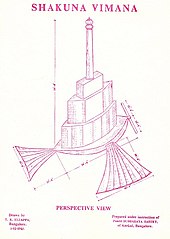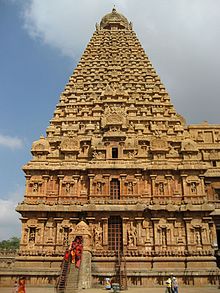Vimāna is a word with several meanings ranging from temple or palace to mythological flying machines described in Sanskrit epics.
http://en.wikipedia.org/wiki/Vimana
Vedas
The predecessors of the flying vimanas of the Sanskrit epics are the flying chariots employed by various gods in the Vedas: the Sun (see Sun chariot) and Indra and several other Vedic deities are transported by flying wheeled chariots pulled by animals, usually horses.
The Rigveda does not mention Vimanas, but verses RV 1.164.47-48 have been taken as evidence for the idea of "mechanical birds":
Ramayana
In the Ramayana, the pushpaka ("flowery") vimana of Ravana is described as follows:
Pushpaka was originally made by Vishwakarma for Brahma the Hindu god of creation, later Brahma gifted it to Kubera, the God of wealth, but was later stolen, along with Lanka, by his half-brother, the demon king Ravana.
The Mahabharata compliments "the all-knowing Yavanas" (sarvajnaa yavanaa), as the creators of the vimanas[4]: The Yavanas, O king, are all-knowing; the Suras are particularly so (sarvajnā yavanā rajan shurāz caiva vishesatah).[5]
According to the Kalpa Sūtra of Bhadra-bāhu, the 24th tīrthaṃkara Mahā-vīra himself emerged out of the great vimāna Puṣpa-uttara;[7] whereas the 22nd tīrthaṃkara Ariṣṭa-nemi emerged out of the great vimāna Aparijita.[8] The tīrthaṃkara-s Abhinandana (4th) and Sumati-nātha (5th) both[9] traveled through the sky in the "Jayanta-vimāna", namely the great vimāna Sarva-artha-siddhi, which was owned by[10] the Jayanta deities; whereas the tīrthaṃkara Dharma-nātha (15th) traveled through the sky in the "Vijaya-vimāna".[11]
A vimāna may be seen in a dream, such as the nalinī-gulma.[12][13]
 The Vaimanika Shastra is an early 20th century Sanskrit text on aeronautics, claimed to be obtained by mental channeling, about construction of vimānas, the "chariots of the Gods".
The Vaimanika Shastra is an early 20th century Sanskrit text on aeronautics, claimed to be obtained by mental channeling, about construction of vimānas, the "chariots of the Gods".
The existence of the text was revealed in 1952 by G. R. Josyer, according to whom it is due to one Pandit Subbaraya Shastry, who dictated it in 1918–1923. A Hindi translation was published in 1959, the Sanskrit text with an English translation in 1973. It has 3000 shlokas in 8 chapters and was attributed by Shastry to Maharishi Bharadvaja,[15] which makes it of purportedly "ancient" origin, and hence it has a certain notability in ancient astronaut theories.
A study by aeronautical and mechanical engineering at Indian Institute of Science, Bangalore in 1974 concluded that the aircraft described in the text were "poor concoctions" and that the author showed complete lack of understanding of aeronautics.[16]
http://en.wikipedia.org/wiki/Vimana
Vedas
The predecessors of the flying vimanas of the Sanskrit epics are the flying chariots employed by various gods in the Vedas: the Sun (see Sun chariot) and Indra and several other Vedic deities are transported by flying wheeled chariots pulled by animals, usually horses.
The Rigveda does not mention Vimanas, but verses RV 1.164.47-48 have been taken as evidence for the idea of "mechanical birds":
- 47. kṛṣṇáṃ niyânaṃ hárayaḥ suparṇâ / apó vásānā dívam út patanti
- tá âvavṛtran sádanād ṛtásyâd / íd ghṛténa pṛthivî vy ùdyate
- 48. dvâdaśa pradháyaś cakrám ékaṃ / trîṇi nábhyāni ká u tác ciketa
- tásmin sākáṃ triśatâ ná śaṅkávo / 'rpitâḥ ṣaṣṭír ná calācalâsaḥ
- "Dark the descent: the birds are golden-coloured; up to the heaven they fly robed in the waters.
- Again descend they from the seat of Order, and all the earth is moistened with their fatness."
- "Twelve are the fellies, and the wheel is single; three are the naves. What man hath understood it?
- Therein are set together spokes three hundred and sixty, which in nowise can be loosened." ("trans." Griffith)
- "jumping into space speedily with a craft using fire and water ... containing twelve stamghas (pillars), one wheel, three machines, 300 pivots, and 60 instruments."[2]
Ramayana
In the Ramayana, the pushpaka ("flowery") vimana of Ravana is described as follows:
- "The Pushpaka chariot that resembles the Sun and belongs to my brother was brought by the powerful Ravana; that aerial and excellent chariot going everywhere at will .... that chariot resembling a bright cloud in the sky ... and the King [Rama] got in, and the excellent chariot at the command of the Raghira, rose up into the higher atmosphere.'"[3]
Pushpaka was originally made by Vishwakarma for Brahma the Hindu god of creation, later Brahma gifted it to Kubera, the God of wealth, but was later stolen, along with Lanka, by his half-brother, the demon king Ravana.
[edit] Mahabharata
One example in the Mahabharata is that the Asura Maya had a Vimana measuring twelve cubits in circumference, with four strong wheels.The Mahabharata compliments "the all-knowing Yavanas" (sarvajnaa yavanaa), as the creators of the vimanas[4]: The Yavanas, O king, are all-knowing; the Suras are particularly so (sarvajnā yavanā rajan shurāz caiva vishesatah).[5]
[edit] Jaina literature
Vimāna-vāsin ('dweller in vimāna') is a class of deities who served the tīrthaṃkara Mahā-vīra.[6] These Vaimānika deities dwell in the Ūrdhva Loka heavens.According to the Kalpa Sūtra of Bhadra-bāhu, the 24th tīrthaṃkara Mahā-vīra himself emerged out of the great vimāna Puṣpa-uttara;[7] whereas the 22nd tīrthaṃkara Ariṣṭa-nemi emerged out of the great vimāna Aparijita.[8] The tīrthaṃkara-s Abhinandana (4th) and Sumati-nātha (5th) both[9] traveled through the sky in the "Jayanta-vimāna", namely the great vimāna Sarva-artha-siddhi, which was owned by[10] the Jayanta deities; whereas the tīrthaṃkara Dharma-nātha (15th) traveled through the sky in the "Vijaya-vimāna".[11]
A vimāna may be seen in a dream, such as the nalinī-gulma.[12][13]
[edit] Vimanas and the Vaimanika Shastra

An illustration of the Shakuna Vimana that is supposed to fly like a bird with hinged wings and tail.[14]
The existence of the text was revealed in 1952 by G. R. Josyer, according to whom it is due to one Pandit Subbaraya Shastry, who dictated it in 1918–1923. A Hindi translation was published in 1959, the Sanskrit text with an English translation in 1973. It has 3000 shlokas in 8 chapters and was attributed by Shastry to Maharishi Bharadvaja,[15] which makes it of purportedly "ancient" origin, and hence it has a certain notability in ancient astronaut theories.
A study by aeronautical and mechanical engineering at Indian Institute of Science, Bangalore in 1974 concluded that the aircraft described in the text were "poor concoctions" and that the author showed complete lack of understanding of aeronautics.[16]



No comments:
Post a Comment